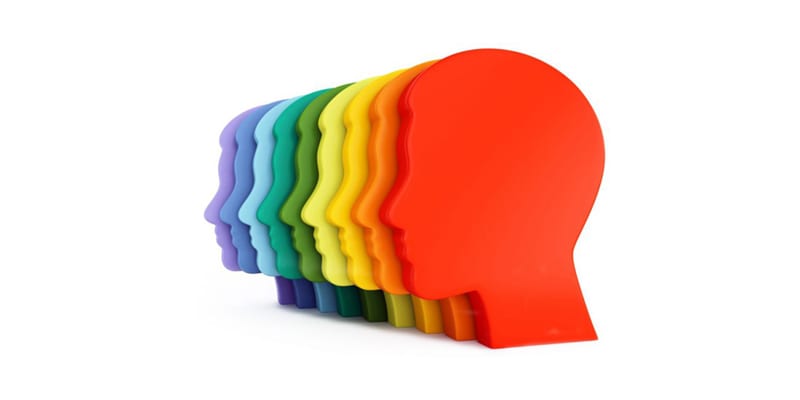Jung Personality Types explained

Jung Personality Types: this article explains the concept of the Jung Personality Types, developed by Carl Jung in a practical way. Next to what it is (origin), this article highlights also the sense and nonsense of personality tests, why use Personality Tests, the Jung Personality Types theory, the definitions of the Jung Personality Types and examples of personality tests. Enjoy reading!
The sense and nonsense of personality tests, based on the Jung Personality Types theory
These days, there are many different personality tests available for anyone to access. Tests that are based on doctor Carl Jung ‘s Personality Types theory especially are gaining significant popularity among managers and supervisors.
But why are personality tests so popular exactly? What is the Jung Personality Types theory? How can you use personality tests in your company? In this article, we discuss the various aspects of personality tests in greater detail.
Why use Personality Tests?
More and more companies conduct personality tests as part of their selection process. The idea is that personality tests are able to validate a potential employee’s true character. During a standard interview procedure, a potential employee may present himself in a better light and hide negative characteristics.
A personality test can assess whether someone is truly suitable for the job. It can also determine whether they’re a good fit for the company as a whole. A good match can reduce employee turnover and increase productivity.
The Jung Personality Types theory explained
Jung first introduced his personality theory in his book ‘Psychological Types’. He used four psychological functions: thinking and feeling (rational functions) and sensation and intuition (irrational functions).
In addition, he distinguishes between two fundamental life attitudes: introversion and extraversion. According to Carl Jung, every person has a dominant life attitude and a primary function. This classifies him or her as a certain personality type.
By combining the different life attitudes and functions, you end up with the 8 Jung Personality Types:
- The extraverted thinking type
- The introverted thinking type
- The extraverted feeling type
- The introverted feeling type
- The extraverted sensation type
- The introverted sensation type
- The extraverted intuitive type
- The introverted intuitive type
Definitions of the Jung Personality Types
To understand the personality theory, it’s important to define the aforementioned concepts the way Carl Jung intended them.
Introverted versus extraverted
Someone who is introverted, focuses on their own mental world. Extraverted people focus more on the world outside themselves.
The thinking type versus the feeling type
The thinking type acts based on reason. Feeling types act on what’s in their heart.
The sensation type versus the intuitive type
The sensation type is led by external sensory stimuli, while the intuitive type is led by undefinable internal feelings.
Dominant life attitude supported by a primary function
As described above, different life attitudes and functions can be regarded as opposites. According to Jung, one life attitude is always dominant. In addition, there’s also a primary function, secondary functions and lower, lesser developed functions.
Take the introverted thinking type, for instance. The introverted thinking type’s dominant life attitude is introversion, their primary function is thinking. Sensation and intuition are the secondary functions, and feeling is the lower, lesser developed function.
What did Carl Jung think of personality tests?
Carl Jung introduced his personality theory as a model to categorise different people for the purposes of psychotherapy. He never intended his model to become a way to label people. If he had known his teachings would be used to define people based on simple questionnaires, he wouldn’t have approved.
Jung mentions opposites in his theory, but he didn’t believe people were on one extreme of the spectrum or the other. The aim is to find a harmonious balance between the different attitudes and functions using psychotherapy.
Jung Personality Types: different Personality Tests
Today, there are many different personality tests based on Jung’s ideas easily available online.
Personality Test Examples are:
- the Myers-Briggs Type Indicator
- the Management Team Roles Indicator
- the Type Dynamics Indicator
- the Jungian Type Indicator
- Insights Discovery
- the Golden Personality Type Profiler
These tests do have a downside, as Jung’s ideas were not intended to select employees based on their character. The results are often snapshots that can be a way to gain some insight into a (potential) employee’s personality.
However, they are hardly scientific. These types of tests miss the mark when it comes to the goal of such personality tests.
The Big Five Personality Test: Professional and scientific
It’s best to choose a professional and scientific test when using a personality test when selecting potential employees. An example is the Big Five Personality Test. The Big Five Personality Test uses five dimensions to define someone’s personality, namely:
- Extraversion/ Introversion
- Agreeableness
- Conscientiousness
- Emotional Stability/ Neuroticism
- Openness to Experience
Conclusion on the Jung Personality Types theory
Implementing a personality test in the selection procedure for potential employees can be an effective method for recruiting people. A good match can reduce employee turnover and increase productivity. It’s better to opt for a scientific test than a test based on Jung’s Personality Types theory.
It’s Your Turn
What do you think? What is your experience with Jung Personality Types and Personality Tests? Do you recognize the practical explanation or do you have additions? What are your success factors for gaining insight into the personality of (potential) employees?
Share your experience and knowledge in the comments box below.
More information
- von Franz, M. L. (1975). CG Jung: His myth in our time. Putnam.
- Jung, C. G. (2014). The development of personality. Routledge.
- McCrae, R. R. & Costa, P. T. (1989). Reinterpreting the Myers‐Briggs type indicator from the perspective of the five‐factor model of personality. Journal of personality, 57(1), 17-40.
- Boyle, G. J. (1995). Myers‐Briggs Type Indicator (MBTI): Some Psychometric Limitations. Australian Psychologist, 30(1), 71-74.
How to cite this article:
Hendriks, F. (2018). Jung Personality Types. Retrieved [insert date] from Toolshero: https://www.toolshero.com/psychology/jung-personality-types/
Original publication date: 02/16/2018 | Last update: 08/09/2023
Add a link to this page on your website:
<a href=”https://www.toolshero.com/psychology/jung-personality-types/”>Toolshero: Jung Personality Types</a>












